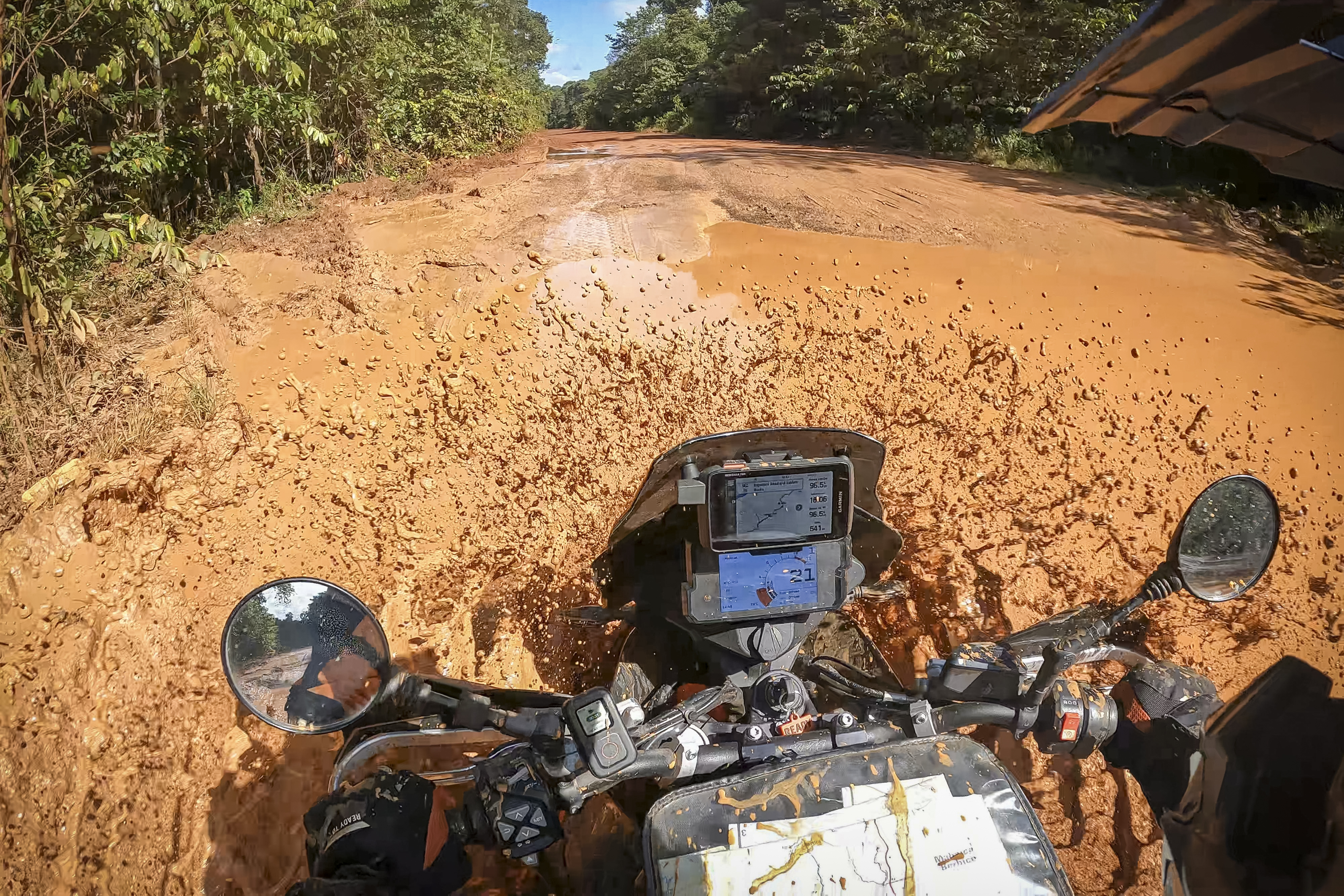In the second part of their South America trip, Joe and Renate Pichler visit the countries in the north of the continent that are rarely toured by motorcyclists: Guyana, Suriname and French Guyana. Muddy tracks through the rainforest make the trip a challenging ride.
Leticia, the capital of the Brazilian Departamento de Amazonas, is located in the middle of the rainforest and cannot be reached by land vehicles. All goods or things of daily use are transported by plane. So too our KTM, which we have flown in from Bogotá, our last stop in Colombia.
And on our first stop in Brazil the Adventure has a break. With the passenger ship "Vitoria Regia" we sail downstream the Rio Solimões. The few cabins are already reserved. But we have our hammocks with us, with which we make ourselves comfortable on the upper deck.
Passing villages for which the boat is the only connection to the outside world, we glide down the sluggishly flowing river and reach Manaus after four days. Manaus, which had become unimaginably rich as a result of the rubber boom, was Brazil's most modern city at the end of the 19th century. In 1896, the Teatro Amazonas, a magnificent opera house, was opened here. Many of the building materials were imported from faraway Europe.
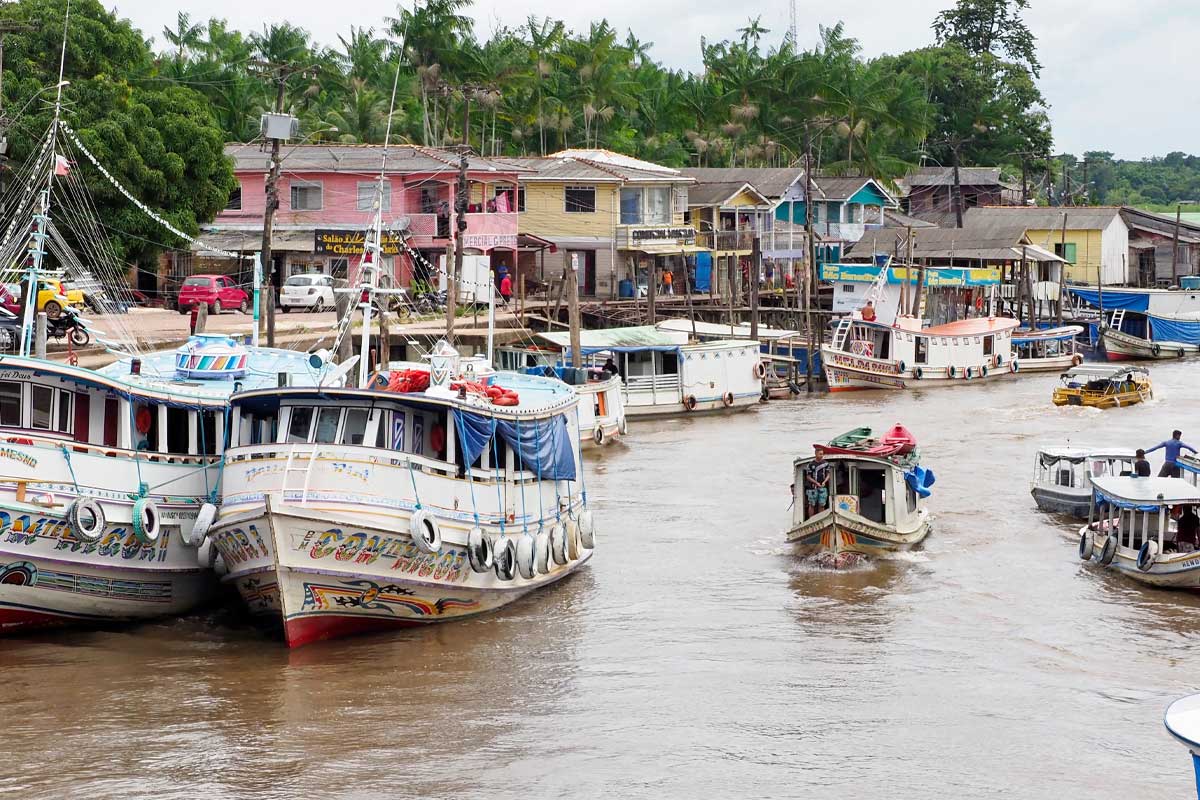
In the Amazon region the boat is the most important means of transport
For us, Manaus is only a stopover on our way to Guyana, Suriname and French Guyana. The BR-174 from Manaus to Boa Vista is a well-built highway, only the daily rain reduces the pleasure of driving. After Presidente Figueiredo, we cross the territory of the Waimiri Atroari. The road leads straight through untouched rainforest. For 120 kilometres it is forbidden to stop or take pictures. North of the protected area for the indigenous people, the rainforest has been cleared, herds of cattle graze along the roadside.
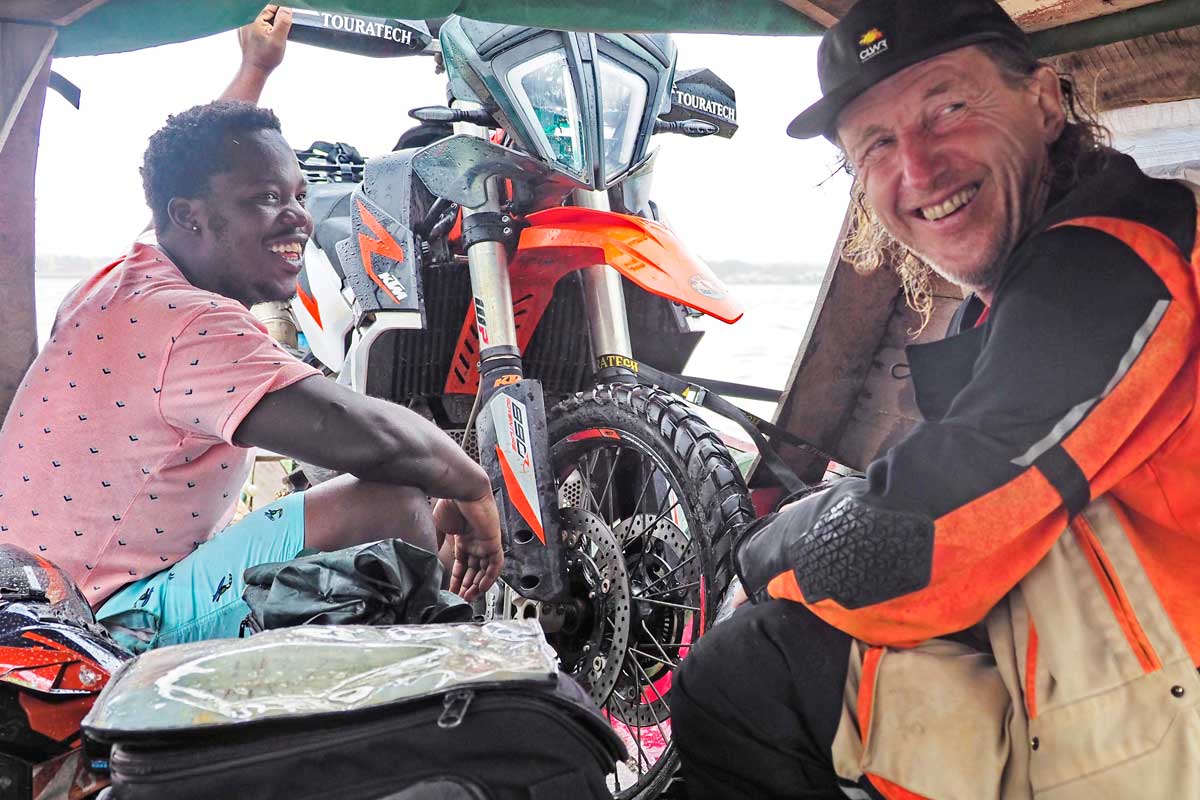
By boat from Suriname to French Guyana
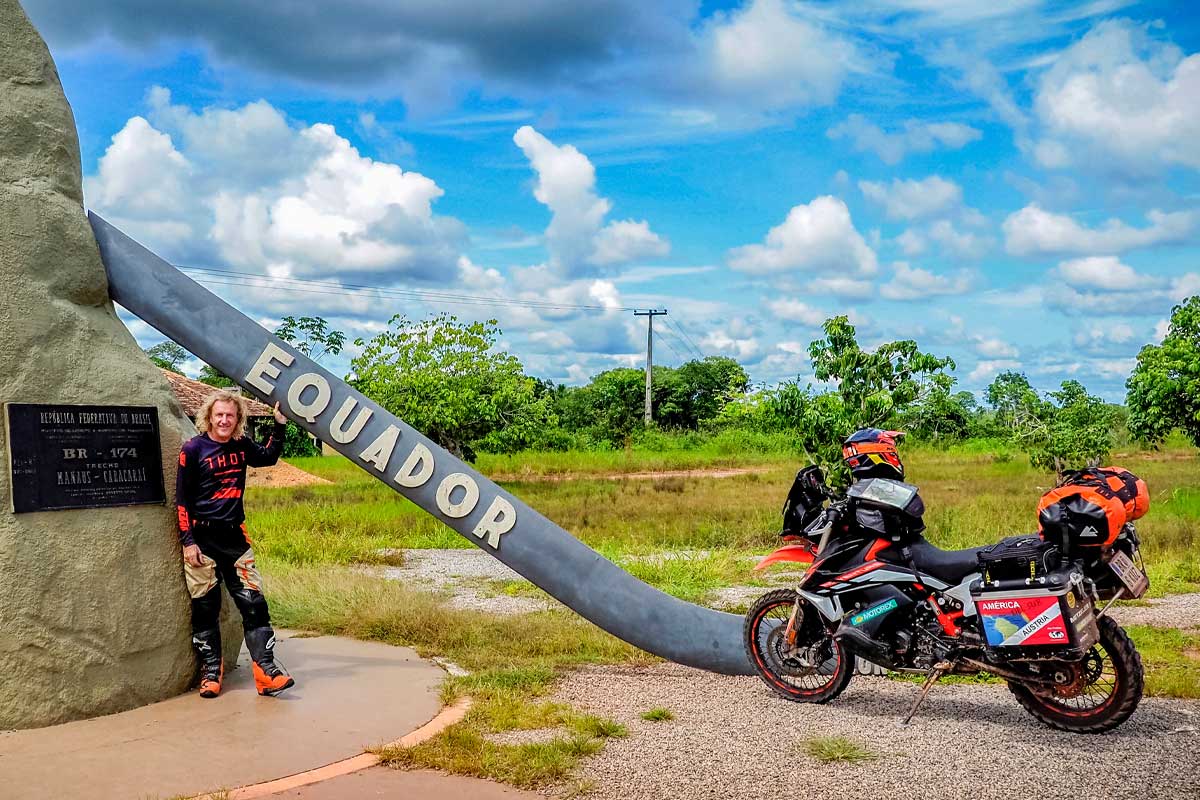
Sculpture at the equator in Roraima
»You must drive on the left side!«
When entering Guyana in Lethem, there is a teeny problem. The vaccination alone is not enough, we have to do an additional test for Covid-19. After 15 minutes of waiting, the surprise is big. Renate tested negative, but I am positive. I definitely did not expect this. We have to go back to Brazil and can't do another test for at least five days. There is a small hotel in Bonfim. Renate gets her own room and provides me with food. I have no symptoms except for a sore throat, the refrigerator is full, and the Internet works. It could be worse.
Seven days later we are tested again and thank God, we are both negative and allowed to enter Guyana. "You must drive on the left side," the border official tells us. Not only has English been adopted as the official language in Guyana from the former British colonial master, but left-hand traffic has also been retained. But on the Lethem-Linden Road, one of the most legendary stretches of road in South America, it doesn't matter at all. 440 kilometres of dirt road lie ahead. After some heavy rain, countless mud holes appear, and everyone just tries to get through somehow. No matter whether on the right or on the left. For me, that's 440 kilometres of off-road fun. Although I'm not sure whether Renate, as a pillion passenger, enjoyed the whole stretch as much.
The Kaieteur waterfall plunges 226 meters into the depths
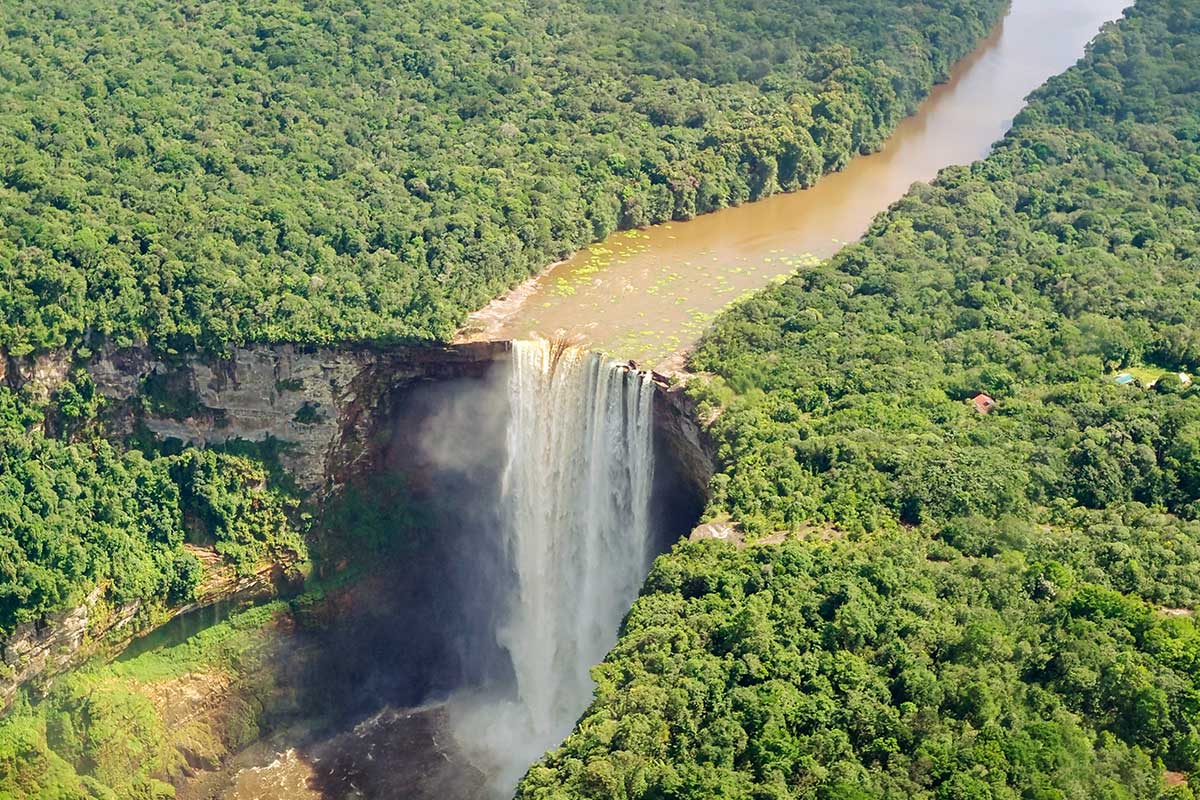
The Kaieteur waterfall in Guyana can only be reached by plane
We can only visit the tourist highlight of Guyana, the Kaieteur Waterfall, by plane. With a height of 226 meters, it is one of the highest waterfalls in America. Afterwards, I did some research on the very peculiar airplane. The Britten-Norman Trislander is not exactly one of the safest models. From its first flight in 1970 to February 2020, there were 26 total losses; that's 36 percent of all planes built. Eight of these air accidents resulted in the deaths of 49 people.
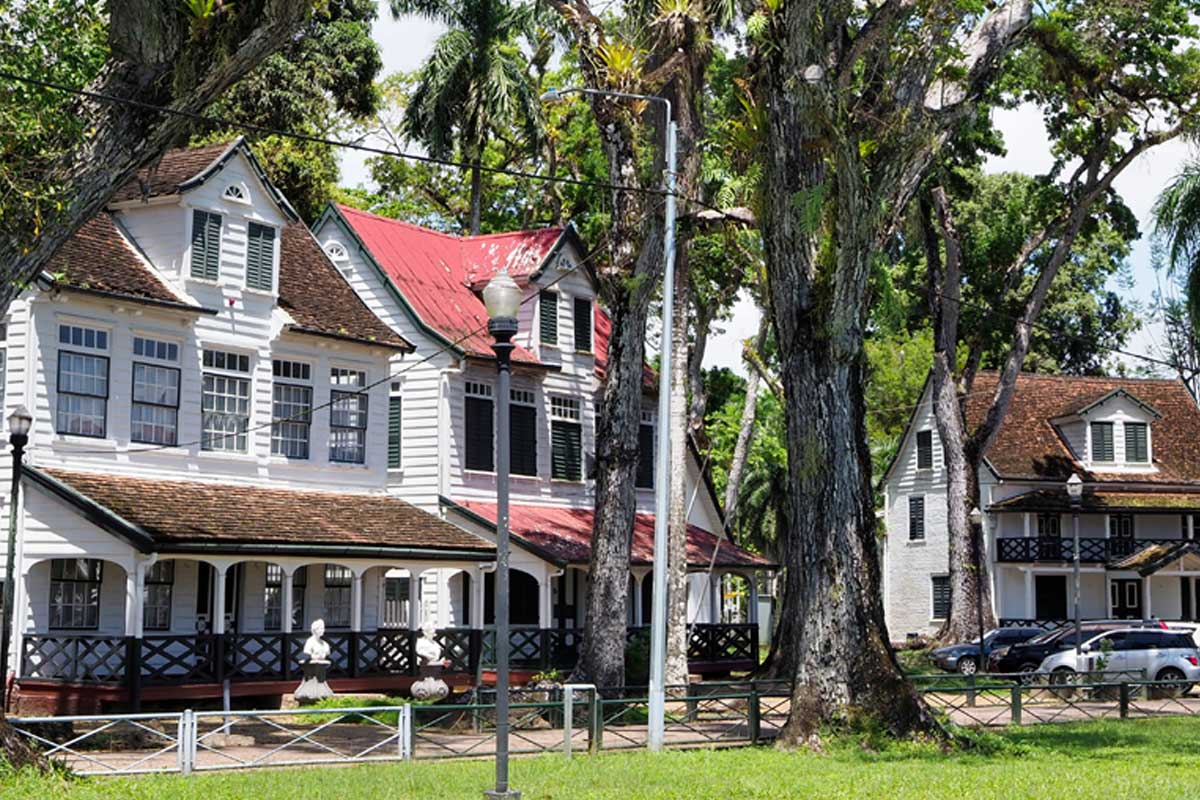
Dutch legacy in Suriname
After a safe landing, we continue to Suriname, a former Dutch colony. With Paramaribo, we reach the capital of the smallest country in South America. Whitewashed wooden houses from the colonial era still characterize the streetscape of the city centre. Suriname is a melting pot of cultures. During the colonial period, men and women from many foreign countries came to South America, more or less voluntarily. Besides the indigenous natives, people of Indonesian, Indian, Chinese, African and European origin live here today. They are Surinamese, but have all preserved their religions and traditions. Paramaribo is home to the Peter and Paul Cathedral, the largest wooden building in South America, and the largest mosque in the Caribbean stands right next to a Jewish synagogue.
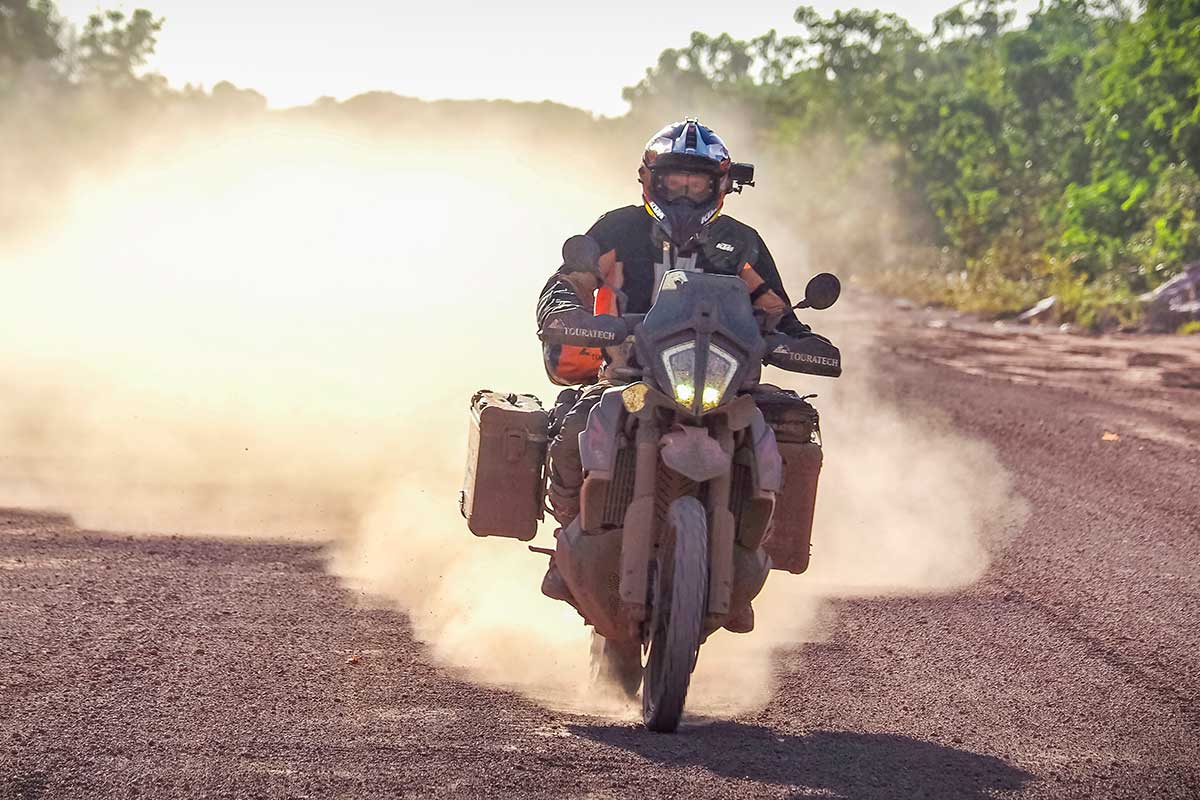
En route on the 440-kilometer Lethem-Linden Road
Somehow, we didn't catch the right time to travel. On the way to Albina it rains continuously. In the border town we park the motorcycle and once again change to the boat to visit the Galibi nature reserve at the mouth of the Marowijne River. After an hour we reach Christiaan Kondre. The inhabitants are indigenous Amerindians and belong to the original inhabitants of Surinam. They take care of the Galibi Nature Reserve, one of the world's largest legend beaches for giant tortoises. There are strict guidelines for visitors, which are very restrictive for us photographers. No flash, and only torches with a red light may be used. Under the cover of darkness, the females come ashore. Egg-laying is hard work for the 150-kilogram animal. It takes five hours for over 100 eggs to be buried in the sand and for the primeval animal to disappear back into the sea.
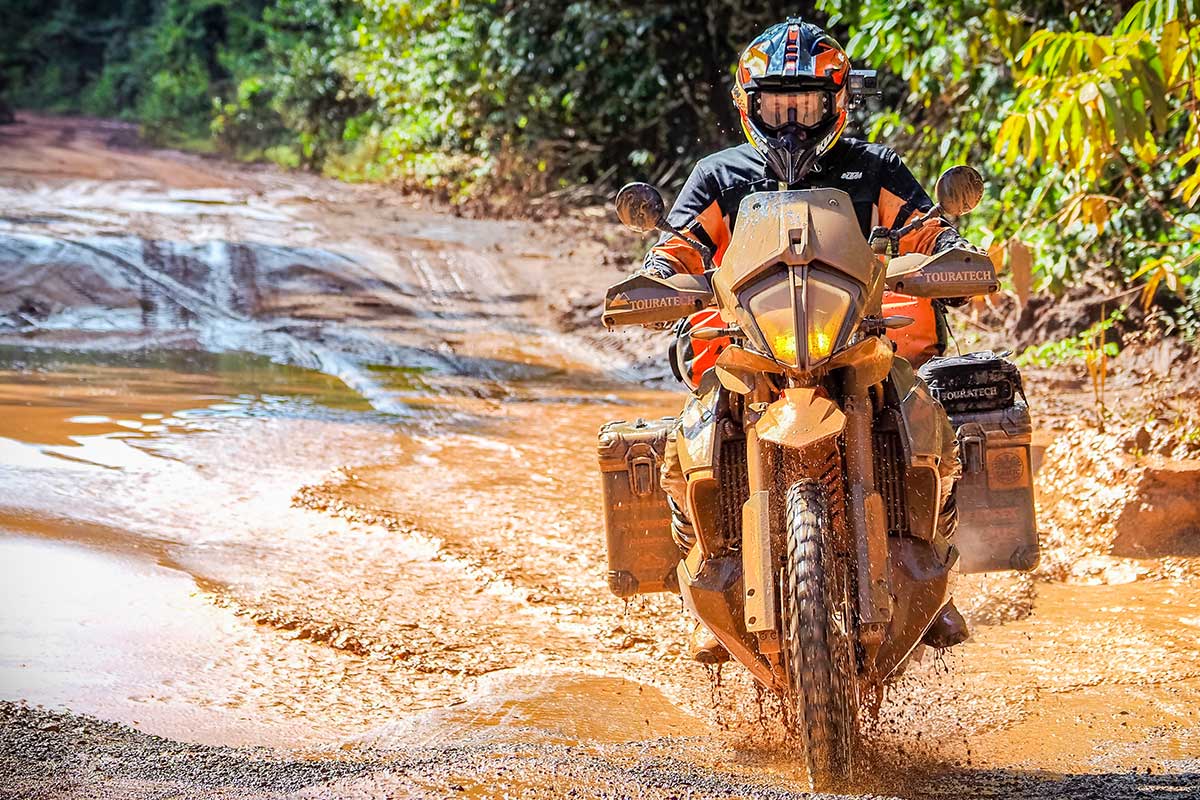
Rains have turned the road to Linden into a mud hole
A litre of beer costs 12 euros - then rather French red wine
We are still in South America, but after a short boat ride across the Marowijne we arrive in a completely different world. French Guiana is an overseas department and politically belongs to France. We don't get an entry stamp in the passport, but we need a liability insurance for the motorcycle. The International Insurance Card valid in Europe is not accepted. We only stay in the country for one week, but the only insurance agent in town sells only a motorcycle insurance which is valid for three months and costs 400 euros. French Guyana is generally an expensive place. A litre of beer costs 12 euros, ten times as much as in Brazil. But French red wine, baguette and Camembert are a welcome change on our menu.
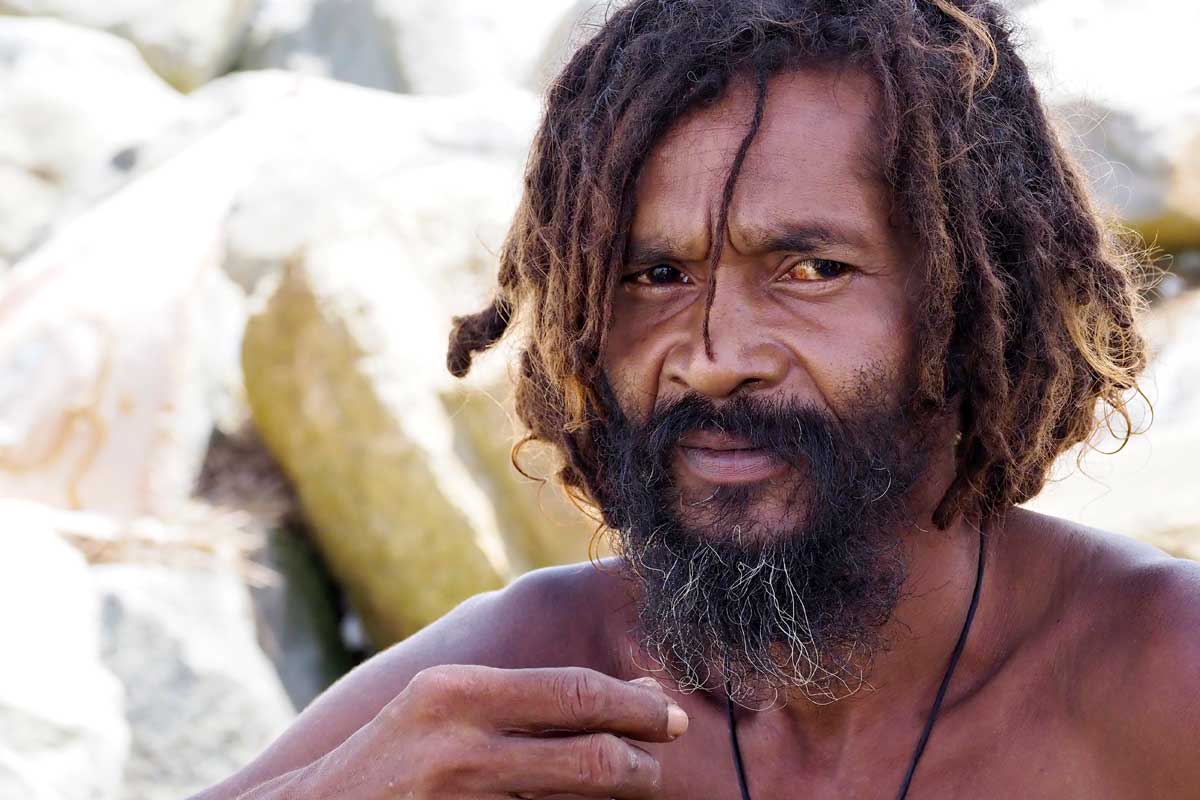
Residents of Christiaankondre organize a visit to the Galibi Nature Reserve
The border town of Saint-Laurent-du-Maroni was once a penal colony and gained some fame through the movie Papillon. It was not until 1953 that the penal colony was closed forever.
Kourou is Europe's only spaceport. Since 1979, not only the European Ariane but also Russian Soyuz rockets have been launched from here. However, after the Russian invasion of Ukraine, the cooperation was stopped by the Russian space agency Roskosmos. All Soyuz launches planned in Kourou were cancelled.
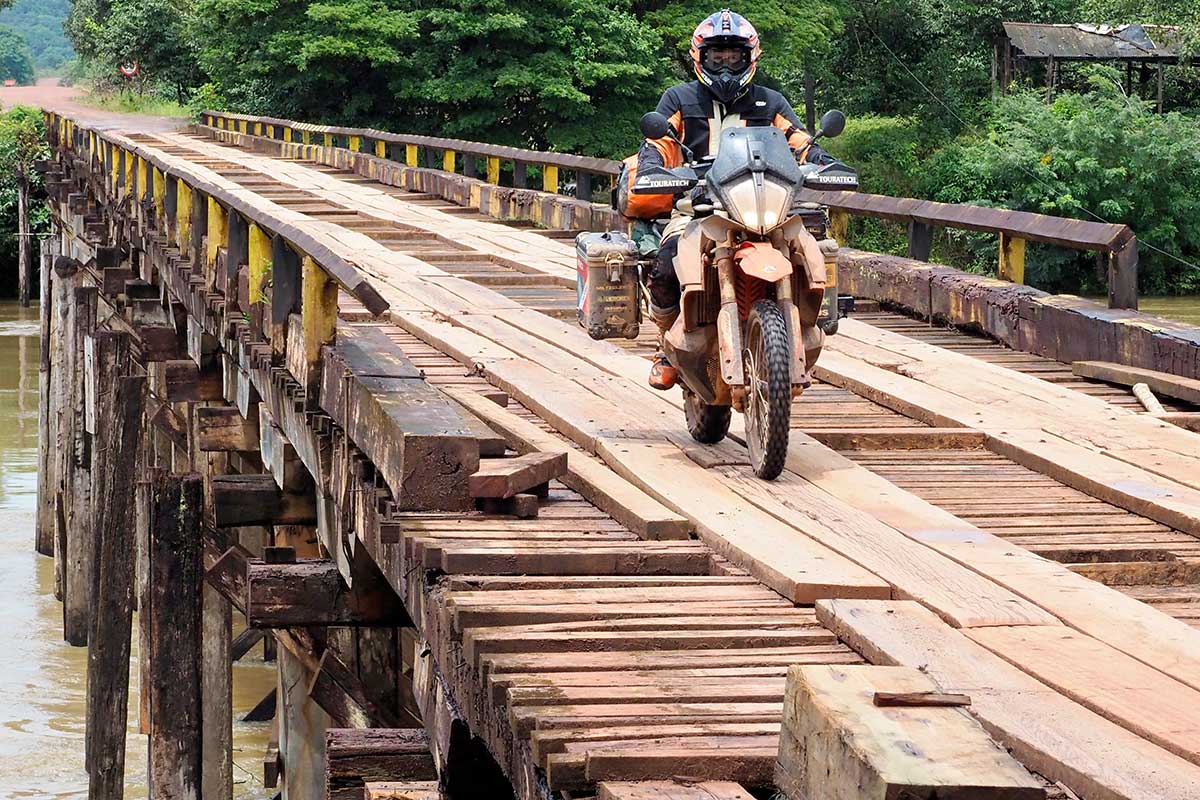
The typical rainforest bridges become slippery when wet
580 kilometres of jungle track await on the way back
In Cayenne, the capital of French Guiana, there is a well-equipped motorcycle store where we have new tires mounted. This is a welcome opportunity for us, because back in Brazil the road to Macapa leads another 580 kilometres through the rainforest. And the rain forest lives up to its name. Short but heavy downpours soften the track, and crossing countless wooden bridges becomes a dangerous slide. In Macapa, the road ends on the banks of the Amazon. We cross the huge Amazon delta on a ship and reach São Luís on the Atlantic coast in time for Carnival Saturday.
A day's journey further east is the Lençóis Maranhenses National Park, Brazil's only desert. Motorcycles are not allowed in the national park. We therefore rent a four-wheel drive vehicle and cross what is actually a dry dune area. During the rainy season, however, water accumulates in thousands of lagoons, creating a completely surreal landscape.
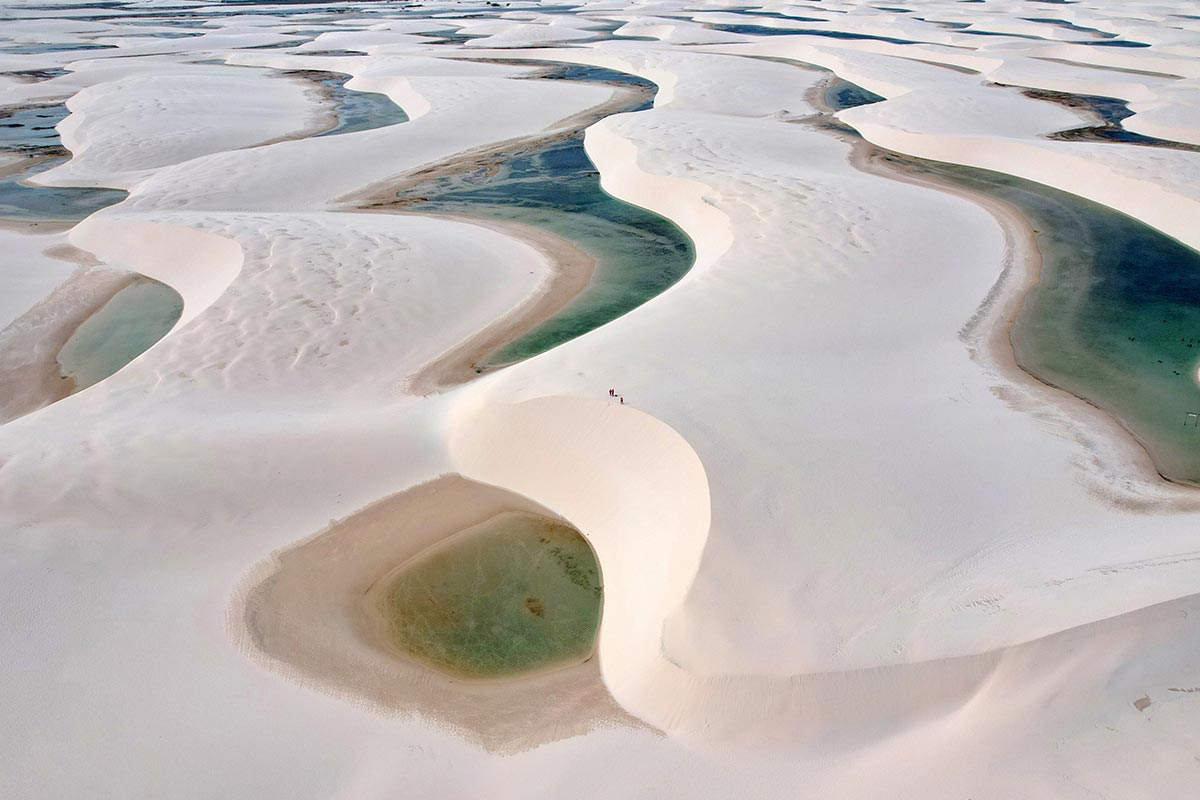
The Lençóis Maranhenses is the only desert in Brazil
Along the Brazilian coast we finally reach Fortaleza, the final stop of our journey through a little-known part of South America.
Arrival and entry
Entry into Guyana via a land border is only possible from Brazil and Suriname. Suriname is only accessible from Guyana and French Guyana. There is also only one border crossing between French Guiana and Brazil, over the bridge at Olapoque.
Documents
A valid passport, national registration and national driver's license are mandatory. A Carnet de Passages is not required. A temporary import permit will be issued upon entry in each country.
Brazil: No additional documents required.
Guyana: Insurance for the motorcycle must be obtained before getting the entry stamp. However, this is not a problem in Lethem. The temporary import permit at the border in Lethem is only valid for three days and must be renewed within this time in Georgetown. An international driver's license is mandatory, but we were never asked for it.
Suriname: Insurance for the motorcycle must already be taken out in Guyana. The E-Tourist Card has to be applied for in advance. Yellow fever vaccination is mandatory. Without these documents you will not get on the ferry across the Corantijn River.
French Guyana: This overseas department belongs politically to France. Insurance for the motorcycle must be taken out in the border town. The bike stays at the border and you have to walk to the insurance broker.
Climate and travel time
In the Amazon region there is the least rain from May to November, but you have to expect a shower every day. On the coasts of the Guyanas it is driest from February to April and from August to October.
Motorcycle, Traffic and Safety
Everything from good long-distance roads to dusty or muddy tracks is available, depending on the weather. Gasoline supply is not a problem. Every touring Enduro has the required range of 250 kilometres anyway.
Health
Observe the current Covid-19 regulations. Vaccinations against tetanus and hepatitis A and B are generally recommended. In the Amazon region, malaria prophylaxis is advisable.
Suriname requires a yellow fever vaccination. Vaccination advice is available at tropical institutes.
Money
Visa ATMs are available everywhere. However, we always carry a supply of Euros and US dollars in cash for emergencies. When leaving the country, exchange the local currency you no longer need at the border.
Communication
For telephone calls within the individual countries it is advisable to buy a local sim card. The domestic card also works, but roaming charges are very high. WIFI is widely available.
In Brazil, some Portuguese is necessary for communication. In Guyana, English is spoken, and it also gets you by in Suriname. In French Guyana, of course, French is spoken.
Literature and Maps
For Brazil, Guyana, Suriname and French Guyana there are road maps available from Reise Know-How Verlag. For GPS, maps from Garmin and Open Street Maps are available. Travel guides for Brazil are offered by Reise Know-how Verlag. For Guyana and Suriname, Bradt Travel Guides are the most up-to-date.
Accommodation and food
Hotels and rooms can be found in all major towns. There are restaurants and snack bars all over the country. You can safely leave the stove at home.
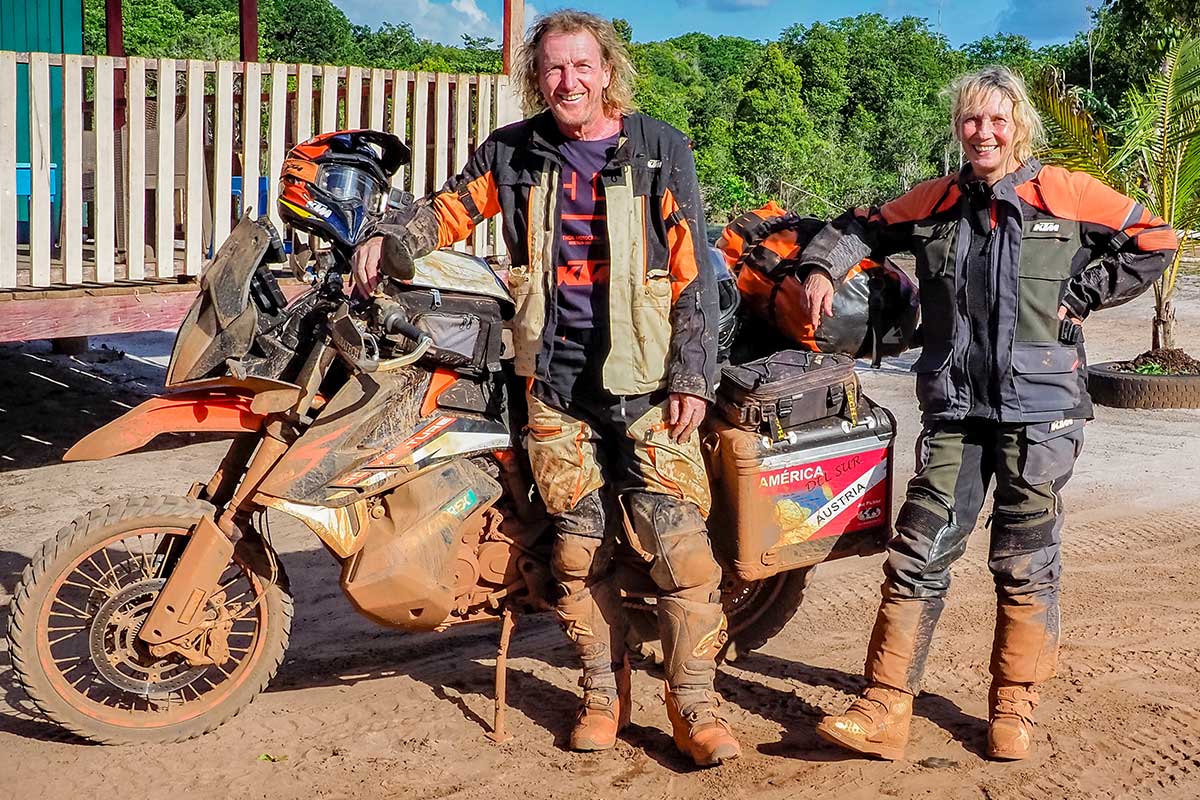
Information on the Internet
E-Visa Suriname https://suriname.vfsevisa.com/suriname/online/home/index
Motorcycle travel forum www.horizonsunlimited.com
Contact the author www.josef-pichler.at












